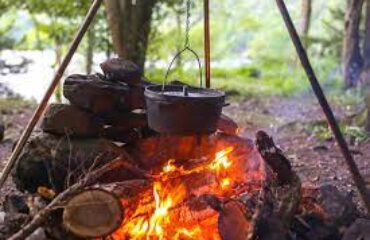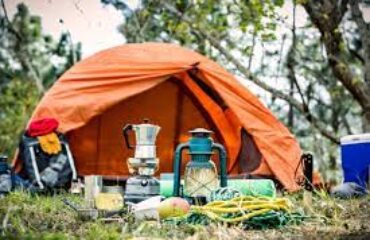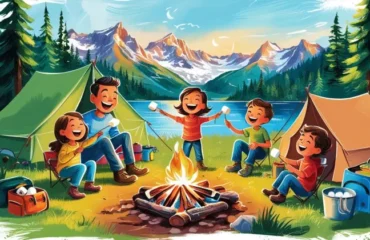Survival Skills 101: Basic Techniques Every Camper Should Know

Camping is a wonderful way to connect with nature and escape the hustle and bustle of everyday life. However, it’s important to be prepared for any situation that may arise while out in the wilderness. That’s where survival skills come in. Knowing some basic techniques can make all the difference in ensuring your safety and well-being while camping. In this blog post, we will cover some essential survival skills that every camper should know.
- Building a Shelter: One of the most important skills to have when camping is being able to build a shelter. In case you find yourself in a situation where you need protection from the elements, knowing how to construct a shelter using natural materials such as branches, leaves, and rocks can be a lifesaver. Practice building different types of shelters before your camping trip so that you are prepared for any situation.
- Starting a Fire: Fire can provide warmth, cook food, purify water, and serve as a signal for help if needed. Knowing how to start a fire without matches or a lighter is an essential survival skill. Practice using methods such as friction-based fire starting techniques like rubbing sticks together or using flint and steel. Always make sure to follow proper fire safety precautions.
- Finding Food and Water: In a survival situation, finding food and water becomes crucial for your survival. Learn how to identify edible plants and berries in the area where you are camping. Additionally, know how to purify water from natural sources such as streams or rivers by boiling it or using purification tablets.
- Navigation: Getting lost while hiking or camping can happen more easily than you might think. Knowing how to navigate using a map and compass is an essential skill for any camper. Practice reading maps, identifying landmarks, and understanding topography before heading out on your trip.
- First Aid: Accidents can happen at any time, especially when outdoors in nature. Knowing basic first aid skills such as treating cuts, burns, sprains, and bites can make all the difference in an emergency situation. Carry a well-stocked first aid kit with you at all times while camping.Whether you’re a seasoned camper or new to the outdoors, knowing basic survival skills is crucial for staying safe and confident in the wilderness. These techniques can help you handle unexpected situations, ensure your well-being, and make the most of your camping adventure. Here’s a guide to essential survival skills every camper should know.
1. Fire Building: Essential for Warmth, Cooking, and Signaling
Why It Matters: A fire can keep you warm, cook your food, purify water, and serve as a signal for help. Knowing how to build a fire under different conditions is a fundamental survival skill.
Basic Techniques:
- Gather the Right Materials: You’ll need tinder (small, easily flammable material like dry leaves, bark, or cotton balls), kindling (small sticks and twigs), and fuel wood (larger logs).
- Choose a Safe Location: Clear a 10-foot radius around your fire pit, removing any flammable material. If possible, use an existing fire ring.
- Build the Fire: Start with a small pile of tinder in the center. Arrange kindling in a teepee or log cabin structure over the tinder. Light the tinder and gradually add larger pieces of wood as the fire grows.
- Keep It Safe: Never leave your fire unattended, and always have water or dirt on hand to extinguish it completely.
Fire in Wet Conditions:
- Use Dry Tinder: Look under logs or inside dead branches for dry material. You can also bring along waterproof fire starters or dry tinder.
- Feather Sticks: Use a knife to shave thin, curly strips from a dry stick. The fine shavings catch fire easily, even in damp conditions.
2. Navigating Without a GPS: Map, Compass, and Natural Indicators
Why It Matters: Technology can fail, so knowing how to navigate using a map and compass, as well as natural signs, is crucial for finding your way in the wilderness.
Basic Techniques:
- Map and Compass Use:
- Orient Your Map: Place your map on a flat surface and align it with the compass so that north on the map matches the compass needle.
- Identify Landmarks: Use the map to identify natural landmarks (mountains, rivers) that can help guide your way.
- Plot Your Route: Draw a line from your current location to your destination and use the compass to maintain your heading.
- Natural Navigation:
- Sun and Shadows: The sun rises in the east and sets in the west. In the Northern Hemisphere, shadows will point roughly north at noon.
- Moss and Vegetation: Moss tends to grow on the north side of trees in the Northern Hemisphere, though this is not always reliable.
- Stars: At night, locate the North Star (Polaris) by finding the Big Dipper constellation. The North Star is part of the Little Dipper and points north.
3. Finding and Purifying Water: Staying Hydrated in the Wild
Why It Matters: Water is essential for survival, and knowing how to find and purify it is crucial if your supply runs low.
Basic Techniques:
- Finding Water Sources:
- Follow the Terrain: Water flows downhill, so look for streams, rivers, or valleys.
- Look for Vegetation: Lush, green areas often indicate the presence of water nearby.
- Morning Dew: Collect dew from plants using a cloth in the early morning. Wring the cloth into a container.
- Purifying Water:
- Boiling: The most effective method is boiling water for at least 1 minute (3 minutes at higher altitudes).
- Filtration: Use a portable water filter or purification tablets to remove bacteria and parasites.
- Solar Disinfection: In a pinch, you can fill a clear plastic bottle with water and leave it in direct sunlight for at least 6 hours. UV rays can kill harmful microorganisms.
4. Basic First Aid: Handling Common Injuries in the Wilderness
Why It Matters: In the wilderness, medical help may not be immediately available, so knowing basic first aid can prevent minor injuries from becoming major problems.
Basic Techniques:
- Treating Cuts and Scrapes: Clean the wound with water and apply an antiseptic. Cover with a sterile bandage or gauze.
- Dealing with Blisters: Prevent blisters by wearing properly fitted shoes and socks. If a blister forms, clean the area, apply a blister pad, and avoid popping it unless it’s necessary to reduce pain or infection.
- Sprains and Strains: Use the R.I.C.E. method—Rest, Ice, Compression, and Elevation—to reduce swelling and pain. Wrap the injured area with a bandage, and avoid putting weight on it until it heals.
- Insect Bites and Stings: Apply a cold compress to reduce swelling. If allergic reactions occur, use an antihistamine or an epinephrine injector if prescribed.
5. Shelter Building: Protecting Yourself from the Elements
Why It Matters: If you’re caught without a tent or need emergency shelter, knowing how to build a shelter can protect you from rain, wind, cold, or heat.
Basic Techniques:
- Lean-To Shelter:
- Find a Suitable Location: Look for a natural windbreak like a large rock or fallen tree.
- Construct the Frame: Lean long branches against the windbreak to create a sloping roof.
- Cover the Roof: Layer smaller branches, leaves, and other natural materials to insulate the shelter.
- Debris Hut:
- Frame: Build a framework with a ridgepole (a long, sturdy branch) supported by two forked sticks.
- Cover: Pile leaves, grass, and other debris over the frame to create insulation. The thicker the layer, the better the insulation.
- Tarp Shelter:
- Simple Setup: If you have a tarp, use it to create a quick shelter by tying it between two trees or securing it to the ground with stakes.
6. Signaling for Help: Attracting Attention in an Emergency
Why It Matters: In an emergency, signaling for help can be the difference between rescue and being stranded.
Basic Techniques:
- Fire Signals: Build three fires in a triangle or a straight line, which is recognized as a distress signal. Use green branches or leaves to create smoke during the day.
- Mirror or Reflective Signal: Use a mirror or any reflective surface to catch the sunlight and direct it towards rescuers or passing aircraft.
- Whistle: Three short blasts on a whistle is an internationally recognized distress signal.
- Ground-to-Air Signals: Use large, contrasting materials (rocks, branches) to create visible signals on the ground, such as an “X” or “SOS.” Ensure the signals are in an open area where they can be easily seen from above.
Conclusion: Be Prepared for the Unexpected
Knowing basic survival skills is essential for any camper. These skills not only ensure your safety but also give you the confidence to handle unexpected situations in the wilderness. Whether it’s building a fire, finding water, or signaling for help, being prepared can make all the difference in your outdoor adventure. Survival skills are not just for extreme situations; they are essential knowledge for any camper venturing into the great outdoors. By practicing these basic techniques before your camping trip, you can ensure that you are prepared for any situation that may arise while enjoying nature’s beauty. Stay safe, be prepared, and happy camping!




